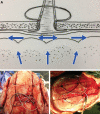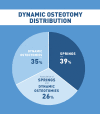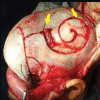Combined Dynamic Osteotomies for Craniosynostosis
- PMID: 37593703
- PMCID: PMC10431354
- DOI: 10.1097/GOX.0000000000005208
Combined Dynamic Osteotomies for Craniosynostosis
Abstract
Background: In primary craniosynostosis, the premature fusion of one or more sutures prevents the perpendicular expansion of brain tissue (primary defect). Providing space for the brain to expand, the compensatory growth of unaffected sutures causes progressive skull deformation (secondary defect). Understanding the need to treat the osteogenic matrix responsible for the cranial vault's shape was essential to develop a novel surgical concept known as dynamic osteotomy. It uses springs to activate stenotic sutures and trigger dura-mater distension while flexibilizing compensatory osseous defects via helicoid osteotomy (nautilus technique), allowing for efficient bone expansion and remodeling in craniosynostosis.
Method: This case series describes patients with craniosynostosis treated with dynamic osteotomy utilizing structural transformation inductors such as springs and helicoid osteotomy (nautilus technique), operated on between July 2004 and January 2020 at a single center in Brazil.
Result: Dynamic osteotomy longitudinally achieved stable osseous remodeling during growth period while maintaining good vitality and continuity of the osteotomized cranial vault.
Conclusion: Dynamic osteotomy utilizing springs and nautilus technique, alone or in combination, is a successful treatment of craniosynostosis regardless of patient's age.
Copyright © 2023 The Authors. Published by Wolters Kluwer Health, Inc. on behalf of The American Society of Plastic Surgeons.
Conflict of interest statement
The authors have no financial interest to declare in relation to the content of this article.
Figures







References
-
- Moss ML, Salentijn L. The primary role of functional matrices in facial growth. Am J Orthod. 1969;55:566–577. - PubMed
-
- Cardim VLN, Perez GMC, Silva AS, et al. . Dynamic osteotomies in mature skulls - Cancum - 2017. Congresso mundial de CraniofacialE - Poster -. In: E - Poster XVII Congress of The International Society of Craniofacial Surgery. 2017.
-
- Lauritzen C, Sugawara Y, Kocabalkan O, et al. . Spring-mediated dynamic craniofacial reshaping. Case report. Scand J Plast Reconstr Hand Surg. 1998;32:331–338. - PubMed
-
- Persing JA, Jane JA, Shaffrey M, Virchow and the pathogenesis of craniosynostosis. Plast Reconstr Surg. 1989;83:738–742. - PubMed
-
- Nocchi Cardim VL, dos Santos Silva A, Salomons RL, et al. . Nautilus-shaped dynamic craniotomy: a new surgical technique and preliminary results. Rev Bras Cir Plást. 2013;28:29–35.
LinkOut - more resources
Full Text Sources
